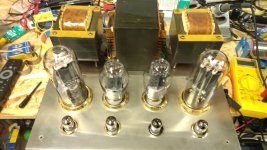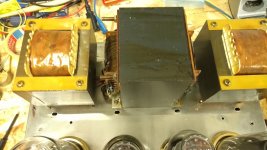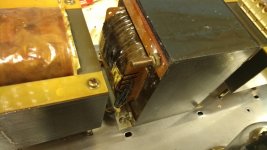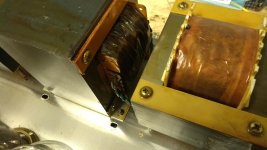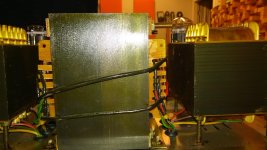If the hum is the same as mains frequency (50 or 60 Hz), it is probably caused electromagnetically, and due to transformer induction or a hum loop. If waving a sheet of steel between a power amplifier’s mains transformer and audio transformer changes the waveform’s shape, then induction is likely
But the waveform is no where near sine wave of AC supply.
But the waveform is no where near sine wave of AC supply.
Attachments
You have 50 Hz. hum, so most likely it’s heater hum. That explains why your extra capacitors don’t work for reducing hum. Perhaps you can reduce hum by decoupling the heater wiring with film capacitors (0.1 - 1 uF for testing). It would be nice if you could try this amplifier with DC in it’s heaters, but that’s quite a change.
Regards, Gerrit
Regards, Gerrit
You have 50 Hz. hum, so most likely it’s heater hum. That explains why your extra capacitors don’t work for reducing hum. Perhaps you can reduce hum by decoupling the heater wiring with film capacitors (0.1 - 1 uF for testing). It would be nice if you could try this amplifier with DC in it’s heaters, but that’s quite a change.
Regards, Gerrit
But the heaters are already DC.. Except for the preamp tubes. Could they be the culprit..?
What is the author & title of this book ? It looks interestingIf the hum is the same as mains frequency (50 or 60 Hz), it is probably caused electromagnetically, and due to transformer induction or a hum loop. If waving a sheet of steel between a power amplifier’s mains transformer and audio transformer changes the waveform’s shape, then induction is likely
But the waveform is no where near sine wave of AC supply.
Have you measured the ripple on the heater’s DC? If you disconnect the heater voltage of the preamp tubes shortly, what happens to the hum?
Regards, Gerrit
Regards, Gerrit
"Building Valve Amplifiers"What is the author & title of this book ? It looks interesting
Morgan Jones (Auth.)
Building Valve Amplifiers | Morgan Jones (Auth.) | download
Building Valve Amplifiers | Morgan Jones (Auth.) | download
If the hum is the same as mains frequency (50 or 60 Hz), it is probably caused electromagnetically, and due to transformer induction or a hum loop. If waving a sheet of steel between a power amplifier’s mains transformer and audio transformer changes the waveform’s shape, then induction is likely
But the waveform is no where near sine wave of AC supply.
Thanks. I have the "valve amplifiers" fourth ed." but this chapter is missing."Building Valve Amplifiers"
Morgan Jones (Auth.)
Building Valve Amplifiers | Morgan Jones (Auth.) | download
Building Valve Amplifiers | Morgan Jones (Auth.) | download
I'll order the above book.
How can I measure/test this?I agree, how about induction between transformers?
Before removing the mains transformer see if a sheet of steel insertedHow can I measure/test this?
between them changes hum. If so enclosing the mains transformer in
closed box of steel might be the solution.
Sometimes mechanical vibrations can be lowered with tightening screws and/or use rubber grommets for chassis mounting. This still does not explain how you get hum from your speakers without tubes installed. This keeps me puzzled...
Regards, Gerrit
Regards, Gerrit
Could it be that because the A+ is running through the output transformer or connected to the output transformer even when there are no tubes mounted noise or 'sonic dirt' transfers to the speakers..?
Sometimes mechanical vibrations can be lowered with tightening screws and/or use rubber grommets for chassis mounting. This still does not explain how you get hum from your speakers without tubes installed. This keeps me puzzled.
It doesn't really sound like a mechanical noise, more electrical.
If you can hear the transformer and not the speakers it’s mechanical. Part of a transformer winding makes minimal movements and cause a buzzing sound. Of cours, without electricity the transformer cannot do anything...
Regards, Gerrit
Regards, Gerrit
I hear the transformer physically and hum/noise from the speakers. That's been the problem from the start..
The mechanical noise of the power transformer with the tubes in place is one problem.
With the tubes removed,
The noise in the loudspeakers is a separate problem.
It is possible to have 2 problems at the same time.
Those are merely the Hum layers of the Onion.
Removing one layer does not fix the other layer.
Is the chassis Magnetic Steel?
That transmits the magnetic emissions of both the power transformer, and from the choke . . . to the single ended output transformers.
A modification of the B+ circuit, like adding More capacitance, especially to the First capacitor in a CLC filter,
will reduce B+ ripple, but may do 3 bad things:
Make the power transformer struggle (get noisy, get hot).
Make the rectifier tube (if any) struggle (get hot, and reduce tube life)
Make the B+ ground loop increase, and inject more hum into the other circuitry.
What is the orientation of the Power transformer coils, the Choke coil, versus the output transformer coils.
Use 90 degree orientation, or expect magnetic coupling of Hum.
Steel chassis means you can never get those Hum levels to zero, no matter the other factors.
With the tubes removed,
The noise in the loudspeakers is a separate problem.
It is possible to have 2 problems at the same time.
Those are merely the Hum layers of the Onion.
Removing one layer does not fix the other layer.
Is the chassis Magnetic Steel?
That transmits the magnetic emissions of both the power transformer, and from the choke . . . to the single ended output transformers.
A modification of the B+ circuit, like adding More capacitance, especially to the First capacitor in a CLC filter,
will reduce B+ ripple, but may do 3 bad things:
Make the power transformer struggle (get noisy, get hot).
Make the rectifier tube (if any) struggle (get hot, and reduce tube life)
Make the B+ ground loop increase, and inject more hum into the other circuitry.
What is the orientation of the Power transformer coils, the Choke coil, versus the output transformer coils.
Use 90 degree orientation, or expect magnetic coupling of Hum.
Steel chassis means you can never get those Hum levels to zero, no matter the other factors.
The loudspeaker Hum layer of the Onion:
The amplifier has Lots of gain.
Any ground loop at the input stage, whether internal, or external (the signal source),
may cause lots of hum.
And any un-bypassed cathode, that has a tube that has filament to cathode leakage can cause Hum.
The amplifier has Lots of gain.
Any ground loop at the input stage, whether internal, or external (the signal source),
may cause lots of hum.
And any un-bypassed cathode, that has a tube that has filament to cathode leakage can cause Hum.
Last edited:
- Home
- Amplifiers
- Tubes / Valves
- Ming-da MC3008-AB hum problem
